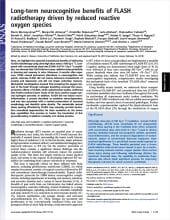Purpose
We highlight the potential translational benefits of delivering FLASH radiotherapy using ultra-high dose rates (>100 Gy·s−1). Compared with conventional dose-rate (CONV; 0.07–0.1 Gy·s−1) modalities, we showed that FLASH did not cause radiation-induced deficitsin learning and memory in mice. Moreover, 6 months after exposure, CONV caused permanent alterations in neurocognitive end points, whereas FLASH did not induce behaviors characteristic of anxiety and depression and did not impair extinction memory.
Mechanistic investigations showed that increasing the oxygen tension in the brain through carbogen breathing reversed the neuroprotective effects of FLASH, while radiochemical studies confirmed that FLASH produced lower levels of the toxic reactive oxygen species hydrogen peroxide. In addition, FLASH did not induce neuroinflammation, a process described as oxidative stress-dependent, and was also associated with a marked preservation of neuronal morphology and dendritic spine density. The remarkable normal tissue sparing afforded by FLASH may someday provide heretofore unrealized opportunities for dose escalation to the tumor bed, capabilities that promise to hasten the translation of this groundbreaking irradiation modality into clinical practice.
Material & methods
Irradiation Devices. Irradiation was performed using a prototype 6MeV electron beam linear accelerator (LINAC) of type Oriatron 6e (eRT6; PMBAlcen), available at Lausanne University Hospital and described previously (43). Physical dosimetry has been extensively described and published to ensure reproducible and reliable biological studies (19, 43–45). This LINAC is able to produce pulsed electron beams at a mean dose rate ranging from 0.1 Gy·s−1 (i.e., comparable to conventional dose rates used in RT) up to 1,000 Gy·s−1, corresponding to a dose, in each electron pulse, ranging from 0.01 up to 10 Gy. All FLASH irradiations were performed at a mean dose rate above 100 Gy·s −1 and at a dose rate within the pulse above 1.8.106 Gy·s −1. The beam parameters used throughout this study are included in SI Appendix, Tables S1–S4. The irradiation settings corresponding to the prescription dose for mouse irradiations were determined by surface dose measurements on a 30 × 30-cm2 solid water slab positioned behind a 1.7-cm-diameter aperture of a graphite applicator (13.0 × 13.0 × 2.5 cm3), as previously described (19). The irradiation settings corresponding to the prescription dose for in vitro and zebrafish embryo irradiations were performed in a T41023 water tank (PTW-Freiburg GmbH) with an Advanced Markus ionization chamber (PTW-Freiburg GmbH) corrected for the drop in ion collection efficiency with increased dose per pulse (46).
Results
FLASH-RT* Does Not Induce Cognitive Dysfunction. We investigated the impact of FLASH-RT on short-term and longer-term neurocognitive sequelae typically found after CONV treatments. Cognitive studies were conducted in tumor-free animals so that behavioral data could be collected and evaluated under carefully controlled conditions and in the absence of confounding disease that would otherwise cause premature death of the animal before long-term analyses.
Conclusion
The relative absence of normal tissue toxicity following FLASH irradiation, also known as the “FLASH effect,” has caught the field by surprise, representing a rather unexpected outcome. Data presented provide compelling evidence that the FLASH effect is, at least in part, mediated by a lower production of ROS. Thus, FLASH may be able to disrupt and bypass ROS-mediated pathogenic cascades that normally lead to neurocognitive complications and associated pathology typically found after CONV irradiation of the brain. The absence of normal tissue toxicity observed after FLASH irradiation and reported here corroborates recent and older work from our laboratories and others on the normal brain, lung, skin, and gut (18, 19, 23, 24) and, as recently reviewed (25), point to the general applicability of FLASH irradiation to avoid normal tissue injury. Normal tissue sparing reported here is especially relevant in the context of current treatment regimens for adult and pediatric brain tumors that elicit significant toxicities that negatively impact patient care and quality of life (5, 26). Since this unfortunate reality remains an unmet medical need, we used tumor-free animals to investigate the short- and long-term neuroprotective mechanisms of FLASH-RT in the absence of confounding disease.
*Ultra-High Dose Rate (UHDR) functionality for FLASH Radiotherapy is for investigational use only and is not cleared for sale by the US FDA.
